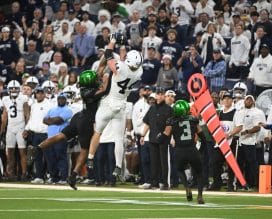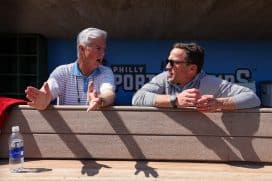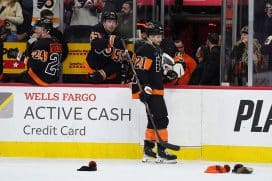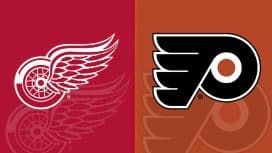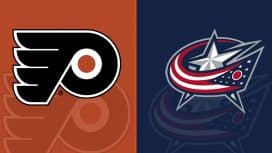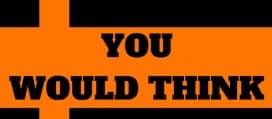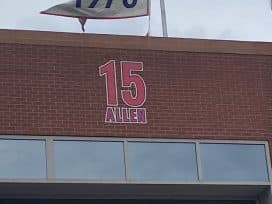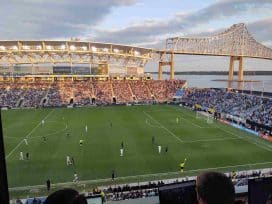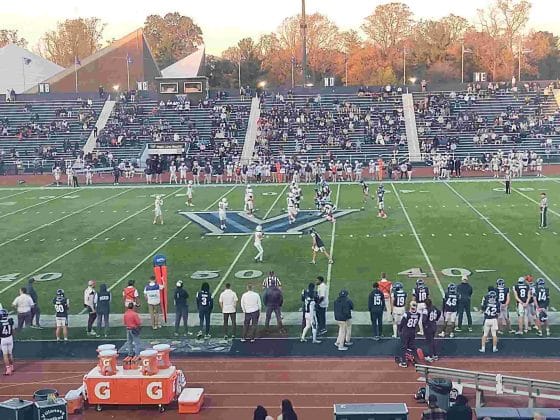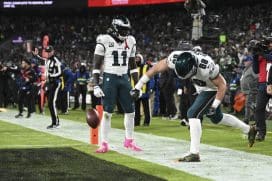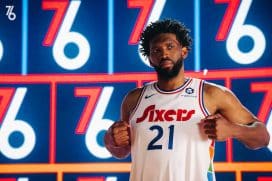Flyers
Flyers Greatest Moments: The Eric Lindros Trade and Debut
By Kevin Durso, Sports Talk Philly editor
One of the most prolific players in Flyers history is Eric Lindros. From his infamous arrival in 1992 to his rather unceremonious exit in 2000, Lindros’ career was always shadowed with controversy.
That said, when he was at his best and his healthiest, Lindros was a dominant player. Had his career not been cut short due to injuries and concussions, he was on his way to topping 1,000 career points and having a bonafide Hall-of-Fame career. And while he was elected to the Hall of Fame in 2018, it has sometimes been forgotten just how good he was in an era when many Hall of Famers suited up.
Here is a look at the early portion of Lindros’ career, from his acquisition to his debut.
Before you get into his first games with the Flyers, you have to look back at how he became a Flyer to begin with.
Lindros was a well-known junior player, highly touted for his talents and leadership. He played for the Oshawa Generals of the OHL and led them to a Memorial Cup in 1990 and was the OHL’s Most Outstanding Player and CHL’s Player of the Year in 1991. Lindros was widely regarded as “The Next One” as a potential successor to Wayne Gretzky as the face of the NHL.
At the 1991 NHL Draft, Lindros was expected to be the top overall pick. However, the Quebec Nordiques held the first overall pick that season — the third straight that they were picking first overall — and Lindros had stated that he would hold out and refused to play for them. Despite this statement, Quebec selected Lindros first overall in 1991. Lindros held true to his statement, and returned to play for Oshawa in 1991-92 instead of making the jump to the NHL. He also participated in the 1992 Winter Olympics.
Following the selection, Lindros had requested an annual salary of $3 million in hopes Quebec would trade him. He also rejected a reported contact offer of 10 years, $50 million in 1992 from Quebec, though the Nordiques have denied this rumor.
The belief at the time was that Lindros’ reasons for refusing to play was that he was anti-Quebec and wanted to be in a more English-speaking area for better endorsement opportunities. The legal counsel to Lindros denied all of those allegations and Lindros himself has since stated that the reason he refused to play there had to do with owner and president Marcel Aubut.
By the NHL Draft in 1992, there were many teams vying for Lindros via trade. The Nordiques were committed to trading Lindros and had discussions with numerous teams.
On June 20, 1992, just before the start of the draft, the Nordiques had reached a verbal agreement with the Flyers on a trade that centered around Lindros. The agreement of the trade was contingent upon Lindros’ approval to play in Philadelphia. The Nordiques granted Flyers GM Russ Farwell permission to call Lindros and get his approval, to which Lindros did accept. Less than two hours after reaching a verbal agreement with the Flyers, Aubut had second thoughts about the trade agreement with the Flyers and orchestrated another trade with the New York Rangers that was also verbally agreed upon.
With two accepted trades on the table, the Flyers filed a complaint with the NHL and following the draft, a five-day arbitration hearing, conducted by Toronto lawyer Larry Bertuzzi, was held to determine a ruling. Bertuzzi reviewed over 400 pages of handwritten notes and called 11 witnesses during the hearing, including Lindros.
On June 30, 10 days after the Nordiques and Flyers had reached a verbal agreement, Bertuzzi delivered his ruling live on international television and radio and determined the Flyers to be the team awarded with Lindros’ rights. Bertuzzi cited the phone call that Farwell made to Lindros as a critical part of making his decision.
Regardless of who received Lindros via trade, the price was going to be a king’s ransom. The Flyers had reportedly offered Mike Ricci, Rod Brind’Amour, Mark Recchi, Steve Duchesne, Ron Hextall, Dominic Roussel, multiple first-round picks and $15 million. The Rangers reported offer was Sergei Nemchinov, Tony Amonte, Alexei Kovalev, James Patrick (the uncle of current Flyer Nolan Patrick), and one of either Mike Richter or John Vanbiesbrouck, as well as multiple first-round picks and $20 million.
When the trade was finalized, the Flyers sent Hextall, Duchesne, Ricci, Kerry Huffman, Peter Forsberg, their first-round pick in 1993, $15 million and future considerations to the Nordiques for Lindros. The Flyers had also agreed to deal a 1992 draft pick to the Nordiques in the trade, but kept the pick through the draft because a trade was not finalized. Bertuzzi helped the two sides finish off the deal with an agreement that sent Chris Simon and a 1994 pick to the Nordiques.
With the trade now official, the Flyers signed Lindros to a five-year, $24 million contract. Lindros made $2 million in his rookie season. Gretzky, who had the largest NHL contract at the time, made $3 million.
Lindros’ first NHL game came on Oct. 6, 1992 in Pittsburgh against Mario Lemieux, Jaromir Jagr and the defending champion Penguins. Goals by Lemieux and Kevin Stevens opened up a 2-0 lead for Pittsburgh. Brent Fedyk scored at 15:07 of third to cut the lead to one, but a late power-play goal in the second by former Flyer Rick Tocchet extended the lead to 3-1.
Just 31 seconds into the third, Lindros struck for his first NHL goal, tipping a loose puck past Tom Barrasso. A goal by Doug Evans just 48 seconds later tied the game at three, and the game would end in a 3-3 tie.
Three nights later, Lindros made his debut at the Spectrum in Philadelphia against the New Jersey Devils. The two teams traded goals in the first period. Andrei Lomakin and Kevin Dineen scored for the Flyers and Randy McKay and Zdeno Ciger scored for the Devils.
Tom Chorske gave the Devils the lead at 12:16 of the second. Brian Benning tied the game at 16:32, but Valeri Zelepukin gave the Devils the lead again with 54 seconds left in the second period.
In the third, Benning scored on the power play to tie the game at 8:11. With time starting to run down in another tie game, Lindros took center stage and delivered in front of the home fans for the first time.
With 4:46 remaining in the third, Lindros broke free on a breakaway after a neutral-zone turnover and turned on the speed, cutting around Chris Terreri as he went for the poke check and tucking a shot into the net, giving the Flyers a 5-4 lead.
The goal stood as the game-winner, as Brind’Amour capped the scoring in the 6-4 win with an empty-net goal with seven seconds remaining.
Video of both of Lindros’ first two goals in the NHL can be seen below:
In a year where the Flyers missed the playoffs for the fourth straight season, Lindros played in 61 games and had 41 goals and 75 points, finishing fourth in Calder Trophy voting behind Felix Potvin, Joe Juneau and unanimous winner Teemu Selanne, and finishing ninth in Hart Trophy voting.
Lindros went on to become the captain of the Flyers in 1994, his third season in the league, and won the Hart Trophy in the lockout-shortened 1994-95 season, scoring 29 goals and 70 points in just 46 games.
Unfortunately, Lindros’ career took a turn over the next half-decade. He suffered multiple concussions that derailed his playing career and both Lindros and his family feuded with GM Bobby Clarke as the relationship between Lindros and the Flyers fell apart. In the 1998-99 season, Lindros had suffered what was diagnosed as a rib injury. Lindros was found lying in a tub, cold and pale, by teammate Keith Jones. Flyers management had said to put Lindros on a plane to return to Philadelphia along with injured teammate Mark Recchi, but Jones insisted that Lindros be taken to the hospital. Lindros was diagnosed with a collapsed lung caused by internal bleeding of the chest wall. Lindros’ father wrote to the Flyers following this diagnosis, stating that if the trainers had followed team orders and put Lindros on a plane back to Philadelphia, he would have died as a result, and doctors supported that statement.
Following yet another season with concussions in 1999-2000, Lindros refused to play for the Flyers and sat out the 2000-01 season as a result. The following August, Lindros was traded to the New York Rangers, ironically the same team that was involved in the arbitration hearing that led to Lindros becoming a Flyer in the first place. Lindros spent three seasons in New York and signed with the Toronto Maple Leafs following the 2004-05 NHL lockout for the 2005-06 season. A wrist injury limited him to just 32 games in Toronto. Lindros then joined the Dallas Stars on a one-year deal for the 2006-07 season. He played in 49 regular-season games and three playoff games before announcing his retirement in November 2007 at age 34.
The series of Flyers Greatest Moments will conclude on Tuesday with a look at the first home of the Flyers, the firsts and lasts of the Spectrum.
